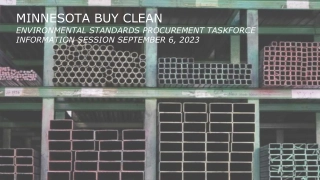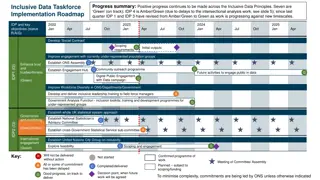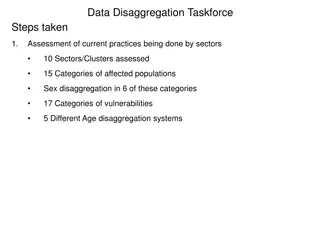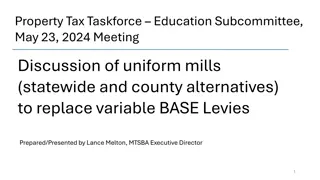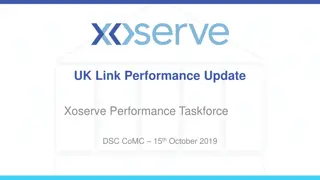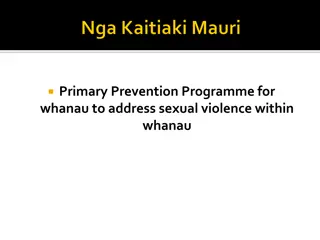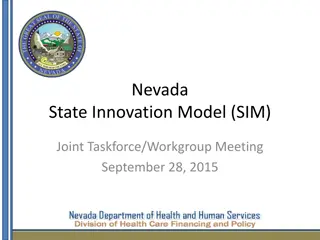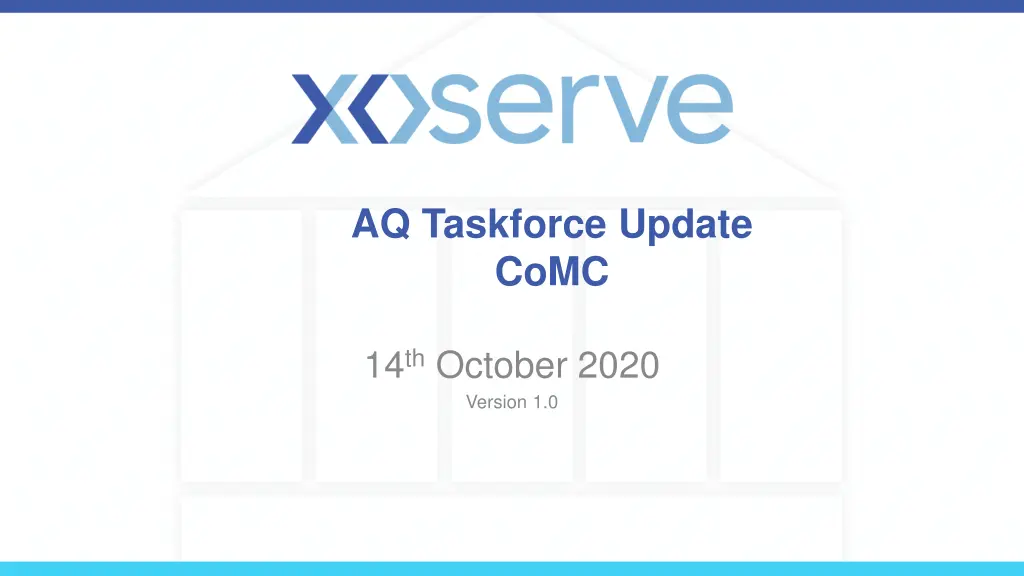
Impacts on AQ Defects Resolution
Understanding the resolution process for AQ defects post Nexus go-live in June 2017, with insights into financial adjustments and document development tools. Discover the methodology, assessment criteria, and tools employed for identifying MPRNs eligible for adjustments and calculating financial corrections.
Download Presentation

Please find below an Image/Link to download the presentation.
The content on the website is provided AS IS for your information and personal use only. It may not be sold, licensed, or shared on other websites without obtaining consent from the author. If you encounter any issues during the download, it is possible that the publisher has removed the file from their server.
You are allowed to download the files provided on this website for personal or commercial use, subject to the condition that they are used lawfully. All files are the property of their respective owners.
The content on the website is provided AS IS for your information and personal use only. It may not be sold, licensed, or shared on other websites without obtaining consent from the author.
E N D
Presentation Transcript
AQ Taskforce Update CoMC 14thOctober 2020 Version 1.0
Background Since Nexus go live in June 2017 there have been 93 (as at July 2020) defects impacting the AQ. Resolution of a defect will involve the system fix, data corrected and the AQs revised. However, revised AQs are only effective for a future date, retrospective changes cannot be made. For AQ defects where the formula year AQ (Class 3 & 4) or rolling AQ (Class 1 & 2) was incorrect for the period prior to the defect fix being implemented, transportation charges may have been incorrect for this period and so eligible for financial adjustments. Energy and Commodity are reconciled on the Amendment invoice, only Transportation Capacity adjustments required Xoserve undertook a piece of work to identify the defects that would require assessment to identify the impacted MPRNs that may be eligible for a financial adjustment. For each defect we sought to analyse the following; The date of the AQ calculation and if a correction of the AQ and Formula Year AQ (FYAQ) was carried out; The effective period for which the correction was carried out; The date that the revised AQ and the FYAQ were effective from Note: The assessment to identify if a financial adjustment is required will continue for all defects in the future.
Documents and Tools Developed and Implemented Two documents were developed and shared with customers to explain the process for identifying those MPRNs eligible for adjustment and a principles document for all adjustments to be processed (these are attached in Appendix 1); Adjustment Methodology that describes the process we have followed to arrive at the 121,000 MPRNS that could be eligible for capacity adjustments Adjustment Principles document that will be used to determine whether an adjustment is required once the final list of MPRNs is identified. Three tools were developed and implemented to identify the MPRNs eligible for adjustment and to calculate the financial adjustments: 1. AQ Decision Tree tool Using our adjustment methodology (above) as its input criteria, this tool will identify the impacted MPRNs and the affected consumption period 2. AQ Simulation tool Using the MPRN s from the Decision Tree tool, the AQ simulation tool will identify all relevant data needed to support the financial adjustment (E.g. current & new AQ, SOQ, EUC band & number, Network & LDZ, start & end read & dates used for the new calculation, TTZ & exchange counts, current meter class & effective date etc.) 3. Billing tool This tool will calculate the financial adjustments. This will significantly reduce the manual efforts that would otherwise be required for these adjustments and will align with the Adjustment Principles (as mentioned above)
Appendix 5: High Level Process for Identifying those MPRNs Requiring a Financial Adjustment All defects impacting AQ from June 2017 were analysed as at July 2020; total of 93 defects, impacting 778k MPRNs. The outcome of the analysis resulted in 58 defects that did not require a financial adjustment, 15 resolved defects (16%) that may be eligible for a financial adjustment. A further 20 defects (22%) from the 93 will undergo the assessment once they have been resolved & AQs re- calculated. Initial analysis has suggested the volume of MPRNs is low. See Appendix 2 for list of all defects analysed and outcome. 93 Defects analysed Following assessment 15 defects were identified as potentially requiring a financial adjustment. These 15 defects impacted 121,584 MPRN, 15 Defects Eligible These MPRNs processed through the tools developed to re-calculate values for the period of the defect 121,584 MPRNs
High Level Process for MPRNs Requiring a Financial Adjustment 3,445 MPRNs to be processed 03/10/20. Remaining 2,549 MPRNs to be further assessed. 15 Defects totalling 121,584 MPRNs identified for Assessment 5,994 MPRNs pending processing 120,651 Unique MPRNs identified for assessment 114,657 passed to Decision Tree tool Note: 933 MPRNs were impacted with more than one defect 330 MPRNs to be re-processed this weekend. Leaving 838 MPRNs to be further assessed. 1,168 exclusions due to unforeseen scenarios identified during validation 61,553 MPRNs as candidates for adjustment. 51,936 MPRNs not eligible for adjustment (appx.3) By Monday 5th October, a further 3,445 MPRNs will be processed (along with 330 MPRNs identified as exclusions) taking total MPRNS processed to 118,102 (97.8%) No additional work required. 3,560 MPRNs rejections requiring further investigation (appx.4) 57,993 MPRNs requiring adjustment Analysis being initiated. Plan to be shared.
Financial Adjustments The total financial adjustments for all MPRNs processed are: CHARGE TYPE CHARGE DESCRIPTION ADJUSTMENT AMOUNT ( ) ACE EXIT CAPACITY LDZ ECN CHARGE ADJ 403.96 CSEPS - LDZ CAPACITY CHARGE ADJ ACZ 3,018.22 AMC CUSTOMER CAPACITY CHARGE ADJ 36,153.79 AME EXIT CAPACITY LDZ ECN CHARGE ADJ 95,237.83 AMF CUSTOMER FIXED CHARGE ADJ 71,419.96 AMZ SUPPLY POINT CAPACITY CHARGE ADJ 951,919.04 1,158,152.80 TOTAL These adjustments are split across: 53 Shippers 5 DNs
Transportation Financial Values - Context Average Capacity charges per month across all DNs is 321,000,000. The financial adjustments for this exercise, in line with the adjustment principles, are spanning an 18 month period The total financial value of 1.1 million = 0.02% of the charges over an 18 month period
Next Steps Date Activity From 30/09/20 Communications issued to customers and contacted individually to discuss the financial adjustment values. w/c 05/10/20 Data will be shared with customers including the line item data used to calculate the adjustments calculated to date w/c 05/10/20 Communications to DNs and Shippers providing details of the remaining financial adjustments (residual) w/c 12/10/20 Start invoicing process of the financial adjustments 14/10/20 Present update to CoMC November onwards As part of BAU, Continue to investigate and analyse all live and resolved defects and assess adjustment requirement.
Appendix 1: Adjustment Methodology (presented at August Contract Management Committee): Adjustment Methodology v1.0 Adjustment Principles (presented at August Contract Management Committee): Adjustment Principles v1.0
Appendix 2: Historical Defects Analysed and Outcome Scenario No. of Defects Open AQ impacting defects as at August 2020. MPRNs affected by these defects will be processed via the adjustment tools once the defect has been resolved (where required data corrected and AQs revised). 20 Resolved AQ impacting defects where AQ values (and therefore FYAQ values) were corrected prior to 1st April 2019. Therefore no financial adjustments required. 17 AQ impacting defects where a data correction was not required therefore AQ & FYAQ values were correct during the period of the defect. No financial adjustments required. 41 Resolved AQ impacting defects where a financial adjustment may be applicable. 15 Total 93
Appendix 3: Decision Tree - Rejection Stats Reason MPRN Count* % 51,388 98.85 Incorrect consumption period not impacting AQ or FYAQ values 596 1.15 FYAQ for 1ST April 2019 was not derived using monthly AQ 1 0.01 Mismatch in FYAQ and AQ as at 1st April 2019 *51,936 Unique MPRNs rejected in total One MPRN can be impacted by more than one rejection if they have multiple adjustments.
Appendix 4: AQ Simulation/Billing Tool Rejection Stats MPRN Count* Reason % Negative Consumption during consumption period. AQ not calculated 363 9.39 Revised AQ value failed validation (market breaker tolerance checks) 6 0.16 Meter read for the AQ period end date not available. AQ not calculated 3088 79.90 Unable to invoice where there is no shipper registered at MPRN 394 10.19 Insufficient Consumption to calculate AQ 14 0.36 * 3,560 Unique MPRNs in total - One MPRN can be impacted by more than one rejection if they have multiple adjustments. Xoserve are working through these rejections to analyse root cause and derive next steps. A plan will be shared once understood.
Summary Following continued analysis and assessment of the enhanced operational reporting, as well as the focused root cause output we have seen an increase in the number of defects over the last few months. The number of open defects now stands at 29 (see AQ Defect Status slide, and Open Defects slide) and following conclusion of yearly AQ activities (where certain system activities needed to be suspended) we expect to see a significant volume being cleared in the next two months. Positively the operational rigor that is now being enforced to the process is driving these defects out allowing for permanent fix to be applied.
AQ Defect Status (breakdown as at 3rd October 2020) 79 Defects impacting AQ since August 2019 (+2 raised since last month) 50 29 Resolved defects (+1 on previous month) Open Defects (+1 from previous month, 10 raised as a result of additional assurance reports) 0 9 5 8 7 Awaiting Deployment (same as previous month) Fixed, Deployed Awaiting Data Correction (+1 on previous month) Awaiting to be processed via adjustment tools Analysis (-5 from previous month) UAT (+4 from previous month) Open defect details can be found in the Appendix
AQ Defect Status (Feb 20 - Sept 20) 90 Increased analysis of newly delivered operational reporting has resulted in an increase over the last two months. 79 77 80 70 The AQ taskforce continues to tackle these through the wider defect process. 60 59 60 56 55 54 52 50 49 47 47 50 44 38 40 35 35 29 28 30 19 17 17 20 13 12 12 10 0 Total Defects Total Open Total Resolved Mar Apr May June July August September October
Open AQ defects 1 of 4 Defect No. Lifecycle Status Issue Description Analysis 62513 When the Cyclic read is received in the Class 3 period before RGMA activity date (D-1), the incorrect energy values are being recorded 63139 Rec flag for the FINX read was updated as N in the Class 3 Reads File (UBR) Table during the cosmetic exchange without read through ONUPD file Analysis Analysis 63346 Volume and Energy is being calculated incorrectly between the Estimated Read (LDEX) and the subsequent Cyclic (CYCL) Read for a Class 3 Meter Point (UBR File) 63392 Estimated Reads are getting derived incorrectly for the Shipper Transfer; hence shipper transfers incorrectly estimated Analysis Class 2 Reads (UDR) File process is unable to perform corrective estimation for Class 2 sites post class change from class 2 to any other class, when the actual read is in the Class 2 period 63485 Analysis Analysis 63494 WAALP Values are getting derived based on timezone as UK instead of GMTUK , for which there is a mismatch in Read derivation (NDM Estimation) 62566 Inconsistent RGMA behavior of class 2 sites with or without DRE/AMR Analysis A read is not getting loaded in the Prime/Sub table after processing the read through the MOD 700 UBR process for Class 3 prime/sub sites under the EUC band - (Identified during UAT of Defect 62178) 62691 Analysis
Open AQ defects 2 of 4 Defect No. Issue Description Lifecycle Status UAT 62784 Where a read is inserted between OPNN and OPNT after reconciliation has been undertaken, the OPNT read is not being considered during the re-rec UAT 63393 For an NDM Prime Site, the Sub site volume and energy is not getting calculated if there is an MRU frequency change for the same class UAT 63394 The Class 3 read Tolerance Validation is passing due to an Incorrect CV calculation, when the last actual read date is before the Go-live Date UAT 62944 The RGMA reads that are accepted between site visit reads is breaking Check to Check rec. The Last Check Read Date is getting fetched incorrectly for Twin Stream Sites when Reads are uploaded through Portal, resulting in either the Read wrongly rejected, or a break in the check to check period. 63480 UAT Site visit Reads submitted via Portal are getting accepted, when an SFN Read already exists for a later date, hence breaking the Check to Check Rec period. Therefore should be rejected for Class 1 & 2 Sites 63486 UAT 63487 Missing volume and energy for a class 4 meter and converter site UAT
Open AQ defects 3 of 4 Defect No. Issue Description Lifecycle Status Fix deployed, awaiting Data Correction 62164 Nett-off volume volume/ energy is being incorrectly calculated as zero for class 4 prime sites Fix deployed, awaiting Data Correction 62178 Where volume and energy is being incorrectly loaded, the system is not creating an exception Fix deployed, awaiting Data Correction For Class 3 meter reads submitted via the UBR file, the system is not recording the last read following update of a meter report and converter installation scenario 63066 60917 (1424)Following an update to a meter (non-physical) the volume which is calculated is based on the opening exchange read (OPNX) as opposed to calculating from the final exchange read (FINX) Fix deployed, awaiting Data Correction Fix deployed, awaiting Data Correction 61452 Rec is not happening for Prime and sub site...
Open AQ defects 4 of 4 Defect No. Issue Description Lifecycle Status 60969 (1477)There is an Issue with NDM Prime reconciliation where Rec variance is not correct and positive variance energy updated though the variance volume is negative and net off volume and energy is populated with 0. To be process via Adjustment Tools To be process via Adjustment Tools 60994 (1502) For Class 3 & 4, following acceptance of a Site Visit read (via SFN) the energy is incorrectly populated when there is a meter and corrector installed 61019 (1520)When receiving a Site Visit read and an RGMA read on the same day the system has incorrectly processed the reads in the wrong order causing energy and volume to be incorrectly calculated. To be process via Adjustment Tools 61024 (1525)AQ process is incorrectly using a Point of Sale (POS) read as an active shipper transfer read to calculate the AQ following the receipt of a subsenquent read. To be process via Adjustment Tools To be process via Adjustment Tools 61450 Reads with type CM, RD and XO on same date as FINC/FINX reads, to be inactivated To be process via Adjustment Tools 61716 Incorrect Volume-Energy updated against opening reads (OPNT/OPNX/OPNC) To be process via Adjustment Tools 62134 Where a read is replaced on a class 4 site, the system has created 0 volume between OPNT and FINC reads To be process via Adjustment Tools 62687 The read inserted or replaced for class 3, after a class change from 3 to another, is considering class 3 FICC date as the next read date To be process via Adjustment Tools 60230 (720) Volume and energy calculated incorrectly for Prime and Sub MPRNs.

